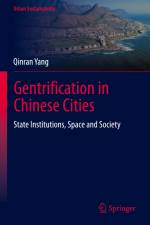av Qinran Yang
1 405 - 1 605
This book provides an institutional interpretation of state-facilitated gentrification in Chengdu, an emerging central city of China. It generalizes the three aspects of institutional changes in the cultural, economic and social spheres that have thus far directed the operation of gentrification in the transitional economy: the creative destruction of consumption spaces, the spatial production of excess, and the unequal redistribution of spatial resources to low-income residents. The interactions of state and society, are examined in navigating the institutional changes and forming the Chinese distinctions of gentrification. The author argues that these three aspects of institutional changes characterize gentrification in Chengdu as a transformative force of development led by the state and capitalists and championed by middle-class consumers. This gentrification mode periodically catalyzes new spaces and collective cultures, which then necessitate the stimulation of new consumption behaviors and the formation of new consumer classes, at the expense of the spatial demands for the even larger number of low-income residents. However, in the context of China's unique state-society relations, some low-income groups may also ride the wave of social transformation. The author suggests that this type of gentrification integrates into not the essence of uneven geographical development in a capitalist society, but China's unique model of urbanization and development, which is often state-driven, innovative and even involuted so as to sustain continuous growth. Though the research is focused on urban China, this book also contributes to methodological issues on gentrification research on a global scale. It is skeptical both of the structural explanation and of the revelation of unsorted differences; instead, it aims to generate midrange regularities of gentrification in Chinese cities. Institutional change is treated as an intermediary that, on the one hand, responds to the global trends and, on the other hand, adapts to local preconditions. Mixed methods, including statistical and spatial analysis, institutional analysis, and an extensive ethnographic study, are used to investigate gentrification from a structural perspective, a historical perspective, and as a grounded process within the locality.

